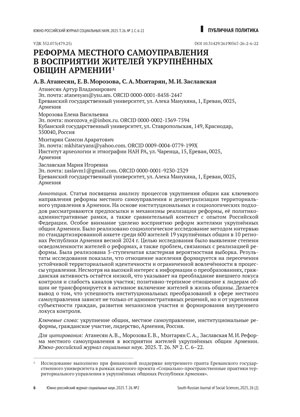Аннотация
Статья посвящена анализу процессов укрупнения общин как ключевого направления реформы местного самоуправления и децентрализации территориального управления в Армении. На основе институциональных и социологических подходов рассматриваются предпосылки и механизмы реализации реформы, её политико-административные рамки, а также сравнительный контекст с опытом Российской Федерации. Особое внимание уделено восприятию реформ жителями укрупнённых общин Армении. Было реализовано социологическое исследование методом интервью по стандартизированной анкете среди 600 жителей 19 укрупнённых общин в 10 регионах Республики Армения весной 2024 г. Целью исследования было выявление степени осведомленности жителей о реформах, а также проблем, связанных с реализацией реформы. Была реализована 5‑ступенчатая кластерная вероятностная выборка. Результаты исследования показали, что отношение населения формируется на пересечении устойчивой территориальной идентичности и ограниченной вовлечённости в процессы управления. Несмотря на высокий интерес к информации о преобразованиях, гражданская активность остаётся низкой, что указывает на преобладание внешнего локуса контроля и слабость каналов участия; позитивно-терпимое отношение к лидерам общин не трансформируется в активное включение жителей в жизнь общины. Делается вывод о том, что успешность институциональных преобразований в сфере местного самоуправления зависит не только от административных решений, но и от укрепления субъектности граждан, развития механизмов участия и формирования внутреннего локуса контроля.
Ключевые слова
Информация о финансировании
Исследование выполнено при финансовой поддержке внутреннего гранта Ереванского государственного университета в рамках научного проекта «Социально-пространственные практики территориального управления в укрупнённых общинах Республики Армения».
Библиографические ссылки
Армянская ССР (например, 1949, 1965, 1981). Административно-территориальное деление. Издание Верховного Совета Армянской ССР. Ереван: Айпетрат.
Арутюнян, Ю.В. и др. (1980). История армянского народа, т. VI. Армения в советский период. Ереван: Изд-во АН АрмССР.
Атанесян, А. (2005). Парадоксы демократии и тенденции демократизации в странах Центральной Азии и Южного Кавказа. Центральная Азия и Кавказ, 6, 13–23.
Большая Советская Энциклопедия (1969–1978). 3‑е издание. Москва: Советская энциклопедия.
Бондарь, В.А. (2016). Демократический централизм и партийное строительство РКП(б) в 1917–1922 гг.: между централизацией и демократией. В 1917 год в России: социалистическая идея, революционная мифология и практика: сборник научных трудов (с. 129–137). Екатеринбург: Издательство Уральского университета.
Бурмистрова, Ю.Ю., Микерин, А.А. (2024). Местное самоуправление периода Советского государства: историко-правовой аспект. Вестник Казанского юридического института МВД России, 15(3), 17–25. DOI: 10.37973/VESTNIKKUI‑2024-57-2
Газелян, Л. (2014, 24 июня). Укрупнение общин с пересечённым рельефом. Голос Армении. Режим доступа https://www.golosarmenii.am/article/24100/ukrupnenie-obshhin-s-peresechennym-relefom
Копотева, И.В. (2017). Теоретические подходы к исследованию реформы местного самоуправления в России. Российский журнал крестьянских исследований, 2(4), 31–55.
Маркварт, Э. (2018). Методические подходы к оценке необходимости и возможных последствий территориальных реформ местного самоуправления. В Местное самоуправление перед лицом современных вызовов: материалы III Всероссийской научно-практической конференции с международным участием 9 ноября 2018 года (с. 177). Владимир: Владимирский филиал РАНХиГС.
Маркварт, Э., Францке, Й. (2017). Территориальное реформирование местного самоуправления в Германии и России на современном этапе. Пространственная экономика, 3, 40–61.
Мартиросян, Г.К., Аветян, А.А. (2017). Укрупнение муниципальных образований как способ сбалансирования развития регионов. В Экономика знаний в России: от генерации знаний и инноваций к когнитивной индустриализации: материалы IX Международной научно-практической конференции (c. 232–238) Краснодар: Кубанский государственный университет.
Морозова, Е.В. (2010). Управление изменениями как проблема политического менеджмента. Полис: Политические исследования, 2, 122–127.
Мухаметов, Р.С. (2019). «Советская» система местного самоуправления в России и её особенности. Муниципалитет: экономика и управление, 2(27), 114–123.
Одинцова, А.В. (2020). Общественный локальный интерес как фактор современного пространственного развития. ВТЭ 1, 106–118.
Сираждинов, Р.Ж. (2024). Анализ изменений полномочий органов местного самоуправления в России в рамках проводимой реформы системы местного самоуправления. Муниципальная академия, 2, 556–561. DOI: 10.52176/2304831X_2024_02_556
Шамсутдинова, Д.В. (2022). Тенденции дальнейшего развития местного самоуправления на примере Республики Татарстан. Ученые записки Казанского юридического института МВД России, 7(2), 117–121.
Штомпка, П. (1996). Социология социальных изменений. Москва: Аспект Пресс.
Штомпка, П. (2001). Социальное изменение как травма. Социологические исследования, 1, 6–16.
Baldersheim, H. (2017). Reflections on 25 years of Local Government Reforms in Europe. Retrieved from https://www.duo.uio.no/handle/10852/43894
Chatry, I., Hulbert, C. (2017). Multi-level Governance Reforms. Overview of OECD Country Experiences. OECD. Retrieved from http://www.oecd.org/publications/multi-level-governance-reforms‑9789264272866‑en.htm
Erlingsson, G.O., Ödalen, J., Wångmar, E. (2021). How Coerced Municipal Amalgamations Thwart the Values of Local Self-Government. Urban Affairs Review. DOI: 10.1177/1078087420921458
Kuhlmann, S., Seyfried, M., Siegel, J. (2017). Wirkungen von Gebietsreformen… Stand der Forschungen und Empfehlungen für das Land Brandenburg. Gutachten — Potsdam. Retrieved from https://www.uni-potsdam.de/fileadmin01/projects/ls-kuhlmann/Gutachten/Gutachten‑11-06-17.pdf
Larichev, A.A., Chikhladze, L.T. (2019). Mend or end: theoretical and regulatory framework of Russia’s local government evolution. Lex Localis, 17(4), 1013–1031.
Ostroff, F. (2006). Change Management in Government. Harvard Business Review. Retrieved from https://hbr.org/2006/05/change-management-in-government
Sahakyan, V., Atanesyan, A. (2006). Democratization in Armenia: Some Trends of Political Culture and Behavior. Demokratizatsiya: The Journal of Post-Soviet Democratization, 14(3), 347–354. DOI: 10.1080/10758200600787692
Swianiewicz, P., Gendzwill, A., Zardi, A. (2017). Territorial Reforms in Europe: Does Size Matter? Territorial Amalgamation Toolkit. Partnership for good Europe. Retrieved from https://rm.coe.int/territorial-reforms-in-europe-does-size-matter-territorial-amalgamatio/168076cf16


